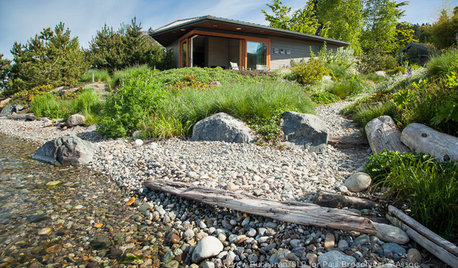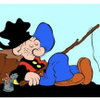Using native/naturalized grasses for a lawn
bpgreen
8 years ago
Featured Answer
Sort by:Oldest
Comments (6)
ZachS. z5 Platteville, Colorado
8 years agobpgreen
8 years agoRelated Discussions
Smothering lawn to use native plant seeds
Comments (19)I think with all the combative language, we have missed an important part of this site: there are TREES there. So the effects of solarization will be substantially reduced. Solarization is mostly used to control soil diseases and nematodes that run rampant in parts of California, studies have shown it only effects about 2" of the soil in terms of sterlization of dormant seeds - it is not really what you need. Just scrape off whatever you can, get some black filter cloth - it blocks light but not water - and put it down, then starting building up some bew compost with whatever you can get your hands on - layer it onto the black cloth and try to get it about 12" deep. You can cut the cloth open in some areas to put in a larger addition, but be sure to remove the soil from the hole and dispose of it rather than mixing it into the compost. Your area will not be hot enough long enough to use solarization for weed removal and the lack of a heat containment below soil during solarization makes its efficiency just terrible related to the work and time required to do it....See Morenative grasses for a SF Bay Area lawn
Comments (1)Festival rubra is probably the fastest to fill in, but will definitely need more frequent mowing than Carex spp's . I've found that Carex praegacilis can have winter dieback when it has to deal with wet clay and little winter sun. Carex pansa is taking a very long time to really fill in in my first application, the lawn is almost 10 months along and still has lots of gaps, I had planted it at about 5 inches on center. In my opinion, Carex divulsa has proven to be the most adaptable, fastest to fill in and most drought tolerant as well as wet feet tolerant of them all. I intend to stick with C.divulsa from now on, although I haven't tried Festuca rubra by itself. If you don't get hung up on the true "California native" pedigree, Berkeley Sedge makes a great lawn with great wear qualities and superior drought and winter performance that the others don't measure up to. If a usable lawn requiring less frequent mowing and just once a month watering is the primary criteria, I'd suggest you get over being a purist about the provenance. The various lawns of each that I've installed are all in the backyards, so not visible from the street. You'll need to address the Oxalis issue first, unless you don't mind the mingling....See MoreHelp w/ changing 3 acres of native grass/weeds to buffalo grass
Comments (6)I must not have been very clear. Buffalo grass is a native grass in my area. It is mixed in with other grasses in pastures and prairie throughout the natural landscape. As our lot currently stands, the weeds (mostly tumbleweeds) have taken over any good prairie grass that is there. We are not planting the 3 acres to lawn, we are planting buffalo grass, which is something we can keep maintained, is native and does not need watered. We are planting over 150 trees and shrubs and plan on introducing a variety of planting beds throughout the property with native wildflowers and ornamental grasses. I feel like we are improving our landscape in a very responsible way and am simply asking for help doing this correctly. Our lot is across from a golf course and although it is in the country (our lot backs a pasture for grazing cattle and circle of corn) it does have to have the look of a manicured area. I frankly feel that people in this area are very good at removing invasive, although "native" weeds that cause a nuisance not only in the way the look but in the amount of water they suck from the ground, and therefore taking over the native grasses. People here plant buffalo grass, keep it mowed and don't water it, which is what we would like to do. Thank you all for your help....See MoreNative grass seeding rates and timing
Comments (38)I seeded on 8/10, so it has been 4 weeks and a day. I was traveling this week, but we got a lot of rain on Tuesday, so my wife turned off the sprinklers for a few days. I think the rain helped things along, because there has been quite a bit of germination in spots. I imagine the temperature drop (highs are finally out of the mid to upper 90s) probably helped as well. I'm still disappointed in the germination in some areas, but I think there may be too much dead KBG in those areas keeping the seeds from being in contact with the soil. I've got at least some germination throughout the lawn, so I think next year, I'll stop watering or start watering every other week, and the natives will take over. I plan to further rough up the areas that had poor germination and drop some seed tomorrow (I kept a little in reserve). I'll also buy some in late winter and do some dormant seeding. I'm also considering buying some "plug flats" in the spring. I'll plant a few seeds in each plug, get it to germinate and plant the plugs in holes I make with a turf hound. I figure that way I can get guaranteed growth in my "target" areas. I reread most of the thread and was amused by David's comment on the KBG "racehorse" because on the lawn forum, everybody bemoans how slow KBG is to germinate. But compared with natives, it's pretty speedy. Depending on how the natives are doing next fall, I may wait for it to cool off a bit and core aerate (didn't do that this time and I think it was a mistake) and overseed again, but with only the western wheatgrass (or maybe also the sheep fescue)....See MoreZachS. z5 Platteville, Colorado
8 years agodigit (ID/WA, border)
5 years agolast modified: 5 years agoeastautumn
5 years agolast modified: 5 years ago
Related Stories

GARDENING GUIDES10 Top California Native Plants, Trees and Grasses
Enjoy a fuss-free, water-wise garden in the Golden State by growing plants naturally in tune with the climate and wildlife
Full Story
GRASSES10 Ways to Use Ornamental Grasses in the Landscape
These low-maintenance plants can add beauty, texture and privacy to any size garden
Full Story
INSPIRING GARDENSLawn Gives Way to a More Natural Lakeside Garden
Meadow grasses, beach pebbles and driftwood replace turfgrass in a nature-friendly landscape on Lake Washington’s shore
Full Story
GARDENING GUIDES5 Great Grasses for a New Lawn
Learn about maintenance, wear tolerance, ideal climate and more for these top turf choices to pick the right one for you
Full Story
GARDENING GUIDES15 Native Flowers That Feed Native Bees
These perennials offer superfood to hundreds of bees and are gorgeous in their own right
Full Story
GARDENING GUIDESGreat Design Plant: Purple Needle Grass, California’s State Grass
The long-lived, drought-tolerant Stipa pulchra is as admired for its benefits as for its good looks
Full Story
LANDSCAPE DESIGN15 Great Ideas for a Lawn-Free Yard
End the turf war for good with hardscaping, native grasses and ground covers that save water and are easier to maintain
Full Story
GARDENING GUIDESSmall Gem Lawns: More Impact From Less Grass
Instead of letting the lawn sprawl, make it a shapely design element in your yard. You’ll reap benefits both practical and aesthetic
Full Story
GARDENING GUIDES10 Top Native Plants for the U.S. Southeast
For a low-maintenance and wildlife-friendly landscape, use Southern natives that withstand heat and humidity
Full Story
NATIVE PLANTS5 Ways to Keep Your Native Plant Garden Looking Good All Year
It’s all about planning ahead, using sustainable practices and accepting plants as living organisms
Full Story



bpgreenOriginal Author